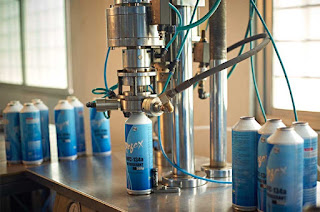Do you want to know how to arrest refrigerant gas leaks in cans? Read the article which explains Anil Jain’s ways to arrest refrigerant leaks as he is an expertise in refrigerant domain for several years. Read the article of Anil Jain and become precautious and secure environment.
Refrigerant gases are threat to the society, if mishandled wrongly. For the past 5 to 6 decades, Chlorofluorocarbons (CFCs) are being used as refrigerants to create air-conditioning and refrigerating effects. Recently, it was identified that CFCs are the most destructive element of the environment. It is regarded as the major causative for ozone layer depletion contributing to global warming (greenhouse effect).
At present large quantities of CFCs filled refrigerant cans are used in a number of air-conditioning and refrigerating systems. Although the movement of refrigerant happens in an enclosed cycle, leakages escape and affect the ozone layer. The most disgusting fact about the refrigerant gases is that they possess remarkably longer atmospheric life. This indicates that if CFCs are leaked in the environment, they may tend to deplete the ozone layer for the next 10 decades. Mr. Anil Jain, CEO of Refex Refrigerant Limited, works for ozone diplomacy in saving the society by suggesting refrigerant leak arresting techniques.
Anil Jain Gases Leak Detection Techniques
Anil Jain Arrest Measures: Simple and Mandatory
Source: How to Arrest Refrigerant Gas Leaks in Cans by Anil Jain
 |
| Refex Refrigerant Gas |
Refrigerant gases are threat to the society, if mishandled wrongly. For the past 5 to 6 decades, Chlorofluorocarbons (CFCs) are being used as refrigerants to create air-conditioning and refrigerating effects. Recently, it was identified that CFCs are the most destructive element of the environment. It is regarded as the major causative for ozone layer depletion contributing to global warming (greenhouse effect).
At present large quantities of CFCs filled refrigerant cans are used in a number of air-conditioning and refrigerating systems. Although the movement of refrigerant happens in an enclosed cycle, leakages escape and affect the ozone layer. The most disgusting fact about the refrigerant gases is that they possess remarkably longer atmospheric life. This indicates that if CFCs are leaked in the environment, they may tend to deplete the ozone layer for the next 10 decades. Mr. Anil Jain, CEO of Refex Refrigerant Limited, works for ozone diplomacy in saving the society by suggesting refrigerant leak arresting techniques.
Anil Jain Gases Leak Detection Techniques
- Any type of methods can be undertaken for both initial test and follow-up verification to cope strong professional judgment. The leak has to be identified and fixed as soon as possible to prevent environmental damage. Some of the simple tests to detect refrigerant leaks include:
- A soap bubble test: If you suspect gas leakage, just pour soap solution on the unit. If bubbles are formed, the leakage is confirmed and necessary steps can be implemented to overcome the problem.
- Electronic leak detectors: An electronic leak detector is a device that produces audio-visual signals when brought near the leakage area. Before the leak spreads all over, the refrigerant gas must be emptied at the easiest.
- Ultrasonic leak detectors: An ultrasonic leak detector is a user-friendly, superior quality, sensitive device helping to detect air leaks through ultrasound. Such type of detector helps to identify the location of leak more precisely.
- A pressure test: It involves filling the container with air and monitoring the increase or decrease in pressure for a specified time period. If pressure decreases, it denotes the presence of leak. Any cracks, split seams, holes, porosity or other conditions causing leaks can be detected by this method.
- Other methods to detect include a vacuum test or fluorescent dye and black light test, an infrared test, and a near infrared (back scatter absorption gas imaging) test.
Anil Jain Arrest Measures: Simple and Mandatory
- Ensure that refrigerant cans are in good condition with caps to seal.
- Make sure that the caps fit properly to the can. If the cap seems to be loose fitting, immediately change the can at the earliest.
- Always store in a place specified by the manufacturer. Temperature places a major role in causing leakage of gas. If the can is to be stored in cool places, it must never be kept in place where the sunlight falls directly.
- Do not beat or drop the can at any cost.
- If the handling process involves technical advice, seek for it rather than experimenting.
Source: How to Arrest Refrigerant Gas Leaks in Cans by Anil Jain
